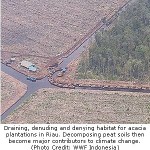
The Horn of Africa is in the middle of its worst drought in more than 60 years following two seasons with no rains that have led to crop failures, wide-spread loss of livestock, and rising food prices in parts of Ethiopia, Kenya, Djibouti, Somalia and Uganda. The situation is now dire with over 11 million people requiring life-saving assistance throughout the region.
As the humanitarian community works to save lives in the areas affected, the need for sustainable solutions to prevent a reoccurrence of this situation in the medium and long-term is becoming increasingly apparent.
“The first and most pressing challenge is to provide food, water and other essentials to the people affected,” said Nick Nuttall, Spokesperson for the United Nations Environment Programme (UNEP). “But addressing some of the root causes must also be part of the eventual solution,” he added.
Myriad factors have contributed to this crisis, with climate change challenges being among them. The region is clearly experiencing at first hand the human consequences of climate change and understanding the link between climate change and development is particularly crucial in Africa, where agriculture and other climate-sensitive sectors are the mainstay of local economies.
This is not the first time that drought has ravished the region. However, prior to the 1970s, extreme climate conditions, such as El Nino, occurred every 10-20 years, which enabled local communities to find coping measures to deal with the impact. But climate change is now eroding these coping measures by causing climatic extremes with greater frequency and intensity. Since 2001, consecutive dry spells in some areas of Africa have led to serious food shortages in many countries.
Investing in the restoration and maintenance of the Earth’s ecosystems – from forests and mangroves to wetlands and river basins – can have a key role in countering climate change as well as climate-proofing vulnerable economies. According to a joint study in 2006 by UNEP and the World Agroforestry Centre on climate change and the impacts and adaptation strategies on agriculture in southern Africa, a number of adaptation measures were cited to tackle the extreme weather events like droughts and floods that come with climate change. Rainwater harvesting, improved crop varieties and climate forecasts as well as forestation were just some cost-effective measures.
The availability of drinking water is of crucial importance in these vulnerable communities. UNEP has been at the forefront of supporting the restoration of Kenya’s Mau forest, which is one of Sub-Saharan Africa’s largest closed canopy forest and the source of the Yala and Nyando Rivers which feed Lake Victoria, provide drinking water and support 5,000 hectares of rice production important for local food security. Decades of deforestation of this single most important water catchment in the Rift Valley and western Kenya have had devastating effects on the country, including severe droughts and floods, which in turn have led to loss of human lives and livelihoods, crops and livestock. Major steps have now been taken to rehabilitate the Mau and in February a multi-million Euro project to assist in the restoration of the complex was announced by the European Union, UNEP and the Government of Kenya.
In Ethiopia, UNEP is partnering with the UN Development Programme (UNDP) and the Food and Agriculture Organization (FAO) to help introduce new policies that will assist pastoralists in managing climate change risks and shocks in six districts. The CC DARE Programme, jointly implemented by UNEP and UNDP, is providing timely-targeted support to nine nationally driven projects, with most of them linked to the agricultural sector and thereby addressing food security, in an effort to speed up the integration of climate risk consideration into policy and national planning to curb vulnerability to climate impacts.
In the Horn of Africa, UNEP has collaborated with UNICEF in water resource management that includes assessments of groundwater resources and formation of water councils to help improved drought resilience and water security. Sharing the lessons learned and gained from such projects will no doubt find an audience among the many people currently impacted by the drought.
“These illustrative projects underline that some communities are trying to build resilience and reduce vulnerability in the face of accelerating environmental change including climate change,” said Mr. Nuttall.
“Scaling these up and accelerating their implementation more widely could prove to be among the keys to a more sustainable and stable future for millions of people in the region,” he added.
Source: UNEP.













